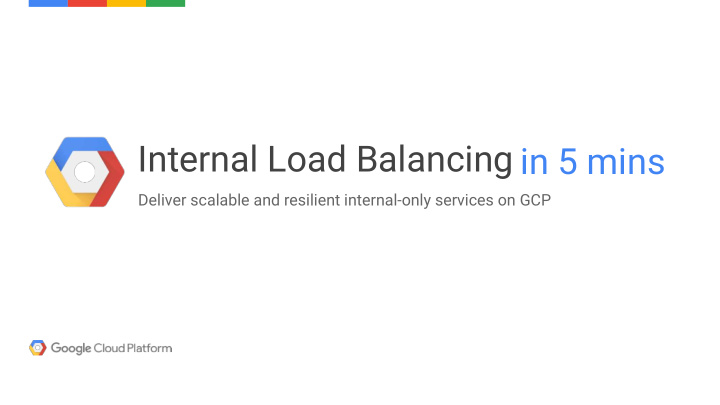



Internal Load Balancing in 5 mins Deliver scalable and resilient internal-only services on GCP
Google Cloud Load Balancing HTTP(S) Load SSL proxy Global Balancing Network TCP/UDP Internal TCP/UDP Regional Load Balancing Load Balancing Hash-based LB Capacity-based LB Global Load Request Routing algorithm algorithm Balancing Cross-region Connection Health Checks Autoscaling Draining failover Affinity Logging Monitoring Cloud CDN
Internal Load Balancing LB IP: 10.10.10.1 Src IP: 10.10.10.1 Src IP: 10.10.10.1 Backend B Client A X Dst IP: 10.10.10.200 Dst IP: 10.10.10.200 Session Affinity Client IP preserved Health checks Internal (RFC 1918) Autoscaling (TCP, HTTP, HTTPS) Load Balancing (no prewarming) gcloud CLI REST API Console
Internal Load Balancing Example Subnet 1 Subnet 2 Subnet 3 Internal LB IP Client instances 10.240.0.200 10.240.0.1 10.240.0.2 Zone: us-central1-b 192.168.1.5 192.168.1.1 Zone: us-central1-a 172.16.1.1 10.240.0.3 Zone: us-central1-c Network: shopnet Google Cloud Platform US Central region Logical representation of the ILB, there is no LB instance between client and backend instances Backends running shopping cart application
Internal Load Balancing Under the hood: Software-defined load balancing is delivered using Andromeda, GCP’s software-defined Andromeda Load Balancers can become network virtualization stack choke points There is no load balancer in the path between your client and backend instances Client Client Client Client ...... ...... instance instance instance instance IP1 IP2 IP1 IP2 Virtual Network VIP Load Balancer Internal LB instance(s) IP3 IP4 IP5 VIP VIP VIP Backend Backend Backend Backend ...... Backend Backend ...... instance instance instance IP3 IP4 IP5 Typical Instance-based Internal Load Balancing Software-defined Internal Load Balancing on GCP
Configuring Internal Load Balancing (console) Infrastructure & Operations 6 6
Internal Load Balancing Configuration Client Instance Internal LB IP, port Forwarding Rule configuration Regional Backend Service Backend 1 Backend 2 Backend 3 Backend Configuration Instance Group 1 Instance Group 2 Instance Group 3 Instance 1 Instance 3 Instance 5 Instance 2 Instance 4 Instance 6 Subnet B Subnet A Region X
1. Click “create load balancer” to get started Click Create
2. Select the type of Internal Load Balancer- either TCP or UDP Click here for TCP ILB
3. Specify you want to load balance traffic between your instances (internal) Specify you want internal load balancing
4. Configure backends in your region of choice Configure backends Remember to open up firewall for ILB health checks
5. Configure your RFC 1918 Internal LB IP (specify or let ILB auto-allocate) Configure Internal Load Balancing IP and port (or list of ports)
6. Click “create” and your ILB is ready to distribute traffic! Click Create. Done!
Internal Load Balancing Use Cases Infrastructure & Operations 14 14 14
ILB Use Case 1: Scaling and HA for internal (micro)services Load balance across multiple instances of your internal service Internal Load Balancer Internal Load Balancer Internal Load Balancer RECOMMEND RECOMMEND SHOPPPING SHOPPING SHOPPPING CART CART CART CATALOG CATALOG Google Cloud Platform Application composed of ILB-scaled services
ILB Use Case 2: Multi-tier apps us-central-1a Internal Load Balancing Web Tier with external load balancing Database Tier IP: 10.10.10.10, Port: 80 Internal Load Balancing Internal Tier Web Tier External Load Balancing Global: HTTP(S) LB, SSL Proxy Regional: Network TCP/UDP LB User in San Francisco Database Tier Web Tier Internal Tier us-central-1b User in Iowa 100.1.1.1, Port: 80 Internal Load Balancing IP: 10.20.1.1, User in Singapore Port: 80 Internal Tier with Internal Load Database Tier Balancing Web Tier Internal Tier asia-east-1a
ILB Use Case 3: Scale-out and HA for virtual appliances Internal Load Balancer 10.0.0.2 10.0.0.3 10.0.0.4 Virtual Appliance Virtual Appliance Virtual Appliance Instance 1 Instance 2 Instance 3 Google Cloud Platform
Learn more https://cloud.google.com/compute/docs/load-balancing/internal/ ‹#›
Recommend
More recommend